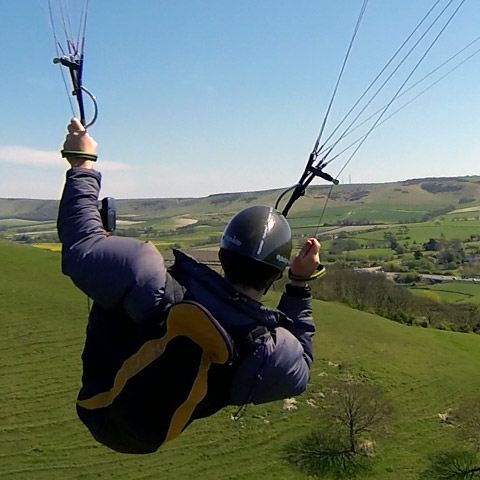
When climbing in thermals, you often see pilots using the outer brake to optimise the turn.
Some gliders respond very well to this technique, giving a flat climbing turn with maximum climb rate.
Hang on a minute! We're trying to turn in a thermal, so we should turn tight. Why pull the other way? Doesn't this just mess up the turn?
How it works
A thermal is seldom even, particularly if there is some wind interfering with it. So while you're going round in circles, there's a lot of beeping and blarping from the vario, signalling changes in climb rates.
You've hit the core, so you're leaning into the turn to get energy and speed then braking the inside, and you're whooping with joy. But what if the whole wing falls out of the thermal core for a moment, or there's a break in the lift?
Your inside wingtip will drop in the sink, and if you do nothing, the turn will tighten too much, and become a spiral because you're leaning in hard. If you lean out of the turn, it's like trying to do a wingover, and in bumpy air it might lead to a big swing and loss of orientation and ... horror ... losing the thermal.
But by using the outside brake at the moment the turn starts to tighten, you can dampen it out and prevent the build-up of energy, while continuing your steady 'easy to visualise' circle.
It also gives you some yaw 'in reserve' if you're already banked and leaning into the corner. When you release the outer brake you get an instant reaction from most wings, a quick 90 degree turn that helps you hang on to the broken bits.
The third reason to use outside brake is to help prevent collapses in narrow cores. The outer wingtip is likely to slip into sinking air from time to time, and so a quick jab on the outside brake can keep it open and lets you continue your tight turn without upsetting your course.

^ Most of the time I use 0-10% outer brake and 30-40% inner brake to control the turn rate, and I use weight shift to change the radius of my turning circles.
Each wing is slightly different, so play around with different combinations until you get a flat, tight, climbing turn that you can easily vary to follow the shifting thermal cores.

Using outer brake will calm the wing down, so only use it when needed. If you use it all the time it will cause a huge circling radius which is frustrating for everyone, as the best lift is almost always in the centre of the thermal. Release the outer brake, tighten the turn, and reapply once you’re nicely banked in.
Brought to you by Flybubble
Like what we do? The best way to thank and support us is to buy gear from us and recommend us to others. Review our service on Trustpilot and our products on Flybubble Shop. You can also subscribe to Flybubble Patreon. Thank you!

